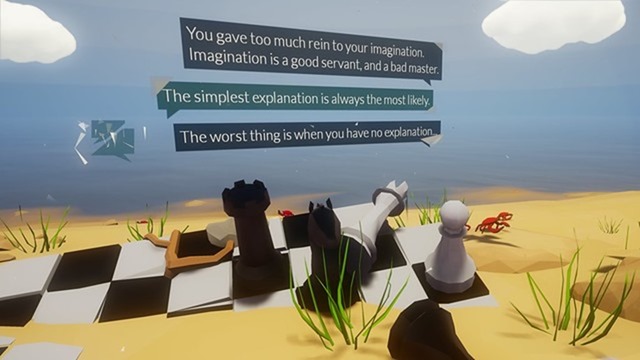I have a great respect for designers that settle on building a puzzle game. Puzzles are complicated things to get right, whole games delicately balancing on the developer’s ability to communicate intentions and goals and the players’ willingness to learn and adapt. Which could be said about most types of games, sure, but puzzle games hedge their entire experience on the player’s willingness to feel like kind of a dumbass.
That’s the thing, a puzzle game’s entire structure and pace is dictated by player’s knowledge of the mechanics at play and if that knowledge isn’t there…well, the game grinds to a halt. No-one wants to be reminded how dumb they are, especially in a past-time that most people engage in to relax. It’s a tightrope that Dreamo finds itself balancing upon at all times and while the puzzles of the game struck a good muddle ground between accessibility and challenge, the rest of the experience was irritating at best.

Like any good puzzle game, Dreamo has a central mechanic that it builds upon gradually as the game progresses. Cubes of gears and knobs that need to be manipulated using a series of free-standing gears and tools are the main dish on service and while they initially seem like a fairly limited concept to build a game around they grow into something far more satisfying.
Serving as MacGuffin to drive the player forward through the coma-induced dreams of protagonist Jack Winslow, the very literal puzzle boxes are all you’ll really be doing in Dreamo other than walking around a dreamscape and watching conversations between Tara, the disembodied voice guiding you through everything. That’s not a bad thing, mind you. You’ll become accustomed to the puzzles, constantly wondering how the next one will test the formula, especially once new mechanics are implemented.

As I said, Dreamo builds upon its foundations in some fairly imaginative ways. Adding gravity, user-manipulated nodes and dimensional shifts into the mix, the puzzles evolve to become quite involved as the game progress. A part of me wishes that these elaborations were explored a little more; Dreamo feels like it’s in an incredible rush to get you through everything. While older elements do sometimes crop up in newer puzzles they always feel like an… extra. An added dimension that’s been slapped in the most obvious way to tick a box. Which is a pity because the few puzzles boxes, or artefacts, that overlap mechanics are really satisfying to solve. They’re just painfully spread out over the game, meaning that even some later puzzles feel way too simple and unsatisfying.

Which is a real pity because the puzzles really were the only thing that kept me engaged with Dreamo. Sure, it’s a puzzle game, that’s a good thing. Yet Dreamo also dabbles in trying to tell the story of Jack Winslow, detailing the events of his life that brought him to be in a coma. It tries to play its hand at being a deep character study of a man who falls prey to his own hubris and arrogance but never actually succeeds in telling what could have been at least an interesting story. I think in a few more drafts with a couple of hard editing sessions, the script could have been there.
What truly lets down Dreamo’s narrative is the voice-acting, which is, to put it bluntly, abysmal. Neither of the main characters, Jack nor Tara, are played with any level of confidence or conviction; one can hear their just reading their lines off a page with little to no direction. It’s rare that you can criticise a video game for poor acting, especially given the levels of production value often thrown into them these days. I’m not going to pretend that Dreamo isn’t an indie game so budget was clearly an issue, yet I have to wonder if it wouldn’t have been better to not have voice-acting at all. Silent conversations springing up throughout the world would have enforced the surreal, dreamlike aesthetic of the game, but whenever someone opens their mouth to say something, I’m instantly prompted to mute the game.

It doesn’t help that Dreamo asks you to stop and remain stationary whenever Jack and Tara have a conversation. I mean, you don’t have to, you can just keep walking past the conversation bubbles and get back to the puzzles. Yet if you want to invest in the story at all, you’ll need to stop walking and just stare at two SMSs having a chat. If I wanted to do that, I’d just watch my friends play around on Tinder for an afternoon. It’s a little thing that just really grated on me the longer I played. Why not just have dynamic conversations that play while you move? It’s a strange decision that has an easy fix.
Which largely sums up Dreamo. It’s a puzzle game built on a solid mechanic which it explores to a meaningful extent but unfortunately wraps itself in a blanket of poor production decisions that just erodes the foundation it builds for itself. If you’re looking for a good puzzle game to kill a few hours, give Dreamo a look, but maybe just turn the volume off so you don’t have to listen to the inane babbling of the characters.
Last Updated: February 20, 2020
| Dreamo | |
|
Built on a solid foundation and offering some unique and engaging puzzles, Dreamo is, unfortunately, let down by its shoddy localisation, canned voice acting and poor writing
|
|
|---|---|
| Dreamo was reviewed on PC | |
|
| |




















